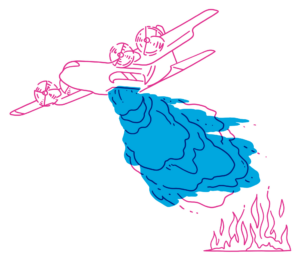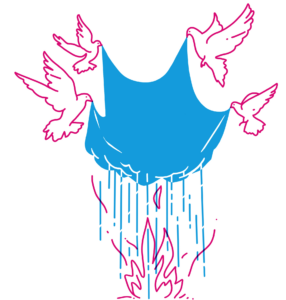Leading emergent change, Chapter 1: Leadership and self-organization
This blog post is the translation of a chapter from a research study I wrote in 2020 for the consultancy LEAD during the Corona crisis.
Two ways to shape change: Leadership and self-organization
To remain successful, organizations need resilience, adaptability and innovation. But how can leaders strengthen these qualities?
Shaping change is an enormous leadership challenge – even without a global crisis. New technologies and the digital transformations they imply are just one factor that put organizations under enormous pressure to adapt. Already in 2005, the German sociologist Hartmut Rosa argued that social and technological change are not only to stay, but ever-accelerating. Change and adaptation are hence the new normal for individuals and organizations, who have to find a dynamic balance as if on “slippery slopes”. Similarly, organizational scientists note that more and more problems in the digital age take the form of paradoxes and contradictions. And management consultants have long used the acronym “VUCA” to describe the key challenges of this world: Volatility, Uncertainty, Complexity, and Ambiguity (see glossary at end of chapter). Managers must not only manage, but navigate through tricky situations with “wicked problems” for which there is no clear approach, no best path, no clear end – and sometimes not even a solution.
Leadership dilemma 1: Leaders should prepare their organization for the future, while having to solve more and more acute problems
Worsening business figures, new processes, staff absences, talent shortages, and tedious meetings: Day-to-day business puts managers under enormous pressure. At the same time, they not only have to manage more and more problems in less and less time, their actual job is to be drivers of change. How can you solve the dilemma of having to achieve more and more with less time, energy and resources?
Leadership dilemma 2: Leaders should bring clarity and order, while being exposed to growing chaos and uncertainty
Leaders not only face more tasks – many of these tasks also become more difficult. Their decisions become more significant, but they have more data to understand in less time. They are expected to provide a clear direction and vision, but they themselves do not know what to expect; to spread optimism, but have to deal with many setbacks themselves. How can leaders solve the dilemma of providing certainty and clarity while the world is characterized by chaos and unpredictability?
Leadership dilemma 3: Leaders are expected to stand firm for one positions, but have to balance changing tensions
It is not only the context of decision-making that becomes more difficult – the decisions themselves are not getting easier, either. There are no easy answers any more. Instead of finding best solutions, two opposing values often need to be balanced. Should you continue to digitized your company, or is human connection more important? Should your organization remember its local roots or strengthen its global partner network? What do you do when revenues are shrinking while risks are growing? Best practice tells you to take a clear position in crisis – but what if it precisely this that provokes resistance? Can you untie the tangle of opinions, perspectives, and values without tightening knots?
Shaping change from the top: Adaptive leadership
Tensions, dilemmas and paradoxes are the essential characteristics of leadership in the digital age. Scientists refer to the leadership style that deals with these contradictions as “ambidextrous” (two-handed). In our 2015 study “Beyond Easy Answers”, we spoke with 31 top leaders to learn how they effectively navigate fields of conflicting tensions.See Baumanns, Bidmon & Sahlmüller (2015). Yet, we did not find “the one leadership approach” for the VUCA world. Instead, managers must switch between different leadership roles depending on the situation, sometimes analyzing precisely, sometimes trusting their intuition; sometimes giving clear instructions, sometimes listening; sometimes setting up structures, sometimes letting things grow; sometimes powering through, sometimes taking a step back. In all of this, it’s the attitude that counts. Today’s literature is rich on good ideas, marketed under labels such as “adaptive leadership”.
Yet, even the best leaders can reach their limit – and many reached their limit already before the crisis. Gallup’s 2019 The Manager Experience study of 50,000 leaders showed that they struggled significantly more than non-leaders with stress (50%) and interruptions (67%). In the 2018 Digital Transformation Report of the Center for Creative Leadership, more than half of the executives surveyed said their organizations lacked the staff and expertise to leverage digital solutions even before Covid. According to one-third of them, top management in particular was unable to serve as role models for digital transformation. It is therefore not surprising that not even half of more than 10,000 employees had confidence in their own managers.
While good leadership with the right approach and attitude can solve many challenges, many leaders will lack the time and energy during crisis to develop a new leadership practice. And even masters of their craft – acting as a lone hero or heroine – might find themselves burned out. Is there hence another way for organizations to adjust, rather than being carried on individual executives’ shoulders?

Allowing change to emerge: Self-organization
In recent years, a second approach for organizations to adapt has become popular: Emergent change through self-organization. While this idea stems from complexity and systems theory, scientists now apply it in management-related organizational science and psychological leadership research. This approach sees the responsibility for successful change not solely with managers, but views organizations as complex systems that must adapt to change as a whole. According to this perspective, it is not primarily the will and actions of individual executives alone that drive change, but the interactions and exchanges between different actors and their environment.
The principle of self-organization describes the sometimes surprising fact that complex systems like organizations do not need central control and leadership to organize themselves. Even very simple rules can lead to very complex patterns of order. In physics, pendulum clocks in a room can synchronize their oscillation frequency by small vibrations in the ground; in biology, flocks of birds and anthills can form seemingly planned patterns of order by each two animals orienting themselves directly to each other; in the social sciences, complex structures in cities stem from interaction and economic exchange between individuals. In all these cases, there is no need for a master clock, an ant queen, or an inner circle to form a recognizable order that adapts well to the outside world. Organizations can also benefit from this. They adapt to the market and their environment not only through the master plan of their central leadership, but through the ideas, coordination, and cooperation of all their employees.As the above examples show, the idea of self-organization finds application in many disciplines, which have different emphases and nuances for the exact definition and conceptualization. For further exploration, we recommend Meadows (2008), Thinking in systems: A primer as a popular introduction, Capra & Luisi (2014), The systems view of life: A unifying vision as an interdisciplinary overview, and Bateson (2016), Small arcs of larger circles as a more philosophical holistic approach. Since this study focuses on application in practice, we refrain from a sharper theoretical location.

Getting through the crisis thanks to self-organization?
Self-organization means not only that leaders lead differently, but that all members of an organization change their own respective roles and perspectives. As a result, this approach has the potential to solve the dilemmas presented above that leaders face in crisis.
Self-organization distributes responsibility for change across several shoulders
According to the first dilemma, executives not only have to take on more management tasks, but also more leadership tasks – even though they have less time, resources, and energy. Even delegating tasks is not a solution, as constant change means that managers must always readjust. By not placing the responsibility for adjustments and changes solely on managers, self-organization helps to solve this dilemma.
Using a school as an example, the principal would not feel solely responsible for coordinating the teaching staff, communicating with the parent body, safety adjustments, digital solutions, and adjustments to teacher expectations, all of which became important during the Covid crisis. Instead, teachers and parents would consciously take responsibility and find solutions to these issues in coordination with each other – for example, by forming working groups, “task forces,” experimentation and expert panels.
Self-organization does not need a clear goal and can thus find a way even in high uncertainty
According to the second leadership dilemma, leaders must provide security to others despite enormous uncertainty. Self-organization solves this dilemma, as not leaders bear the responsibility for change alone, but the whole team. Remaining capable of action even without a clear plan is the group’s responsibility – reducing pressure on leadership and increasing everyone’s readiness for incremental progress. Instead of complaining about or being irritated by a lack of answers, employees can contribute to their solution themselves.
In the example of the school, the principal would not have to define decisions for a digital platform, the scope of the new curriculum, and rules for the new start from the beginning. Teacher and parent representatives see it as a process to creatively resolve these issues step by step. Differences between school classes are not seen as a lack of coordination on the part of the school management, but as an opportunity to learn from the experiences of others.
Self-organization allows to resolve tensions with all parties involved
According to the third leadership dilemma, leaders cannot find “best” solutions but need to navigate through paradoxical tensions. In a systemic way, picking one side over the other only raises resistance. But leaders who just meander in the middle are accused of lack of clarity and lazy compromise. Self-organization mitigates this dilemma as it removes blame from leaders and allows everyone to understand smaller parts of the problem and actively seek syntheses.
During Covid, schools had to balance many opposites. Safety or education, pushing through the curriculum or allowing for leeway – and how to share the burden between pupils, teachers, and parents? Self-organization often shifts the question of the right balance from a political debate to a joint, creative search for a middle ground that works. In the process, new solutions can emerge.
All these examples illustrate that self-organization can be a helpful approach when dealing with a crises. But does such an abstract idea do justice to actual problems? And if so, how does it work? What does this mean for leaders, what does it mean for organizations? These questions are the focus of the next chapters. As we will show, self-organization has played an important role in finding answers to the big social crisis in Germany: the so-called “refugee crisis.” Since the media-established term “refugee crisis” implies that the crisis is the fault of the people who have fled, this common designation of this crisis is used here in quotation marks. Here, more than 11 million Germans have engaged in the “welcome movement” to support the more than one million new arrivals and to find answers to the changes they put into motion. To find out how this has worked, we spoke with 24 public administration officials, shelter operators, initiators of volunteer initiatives, leaders of innovation projects, and founders of social startups. In the next chapter, we will present what leaders can learn from them to solve short-term, mid-term and long-term challenges pragmatically using the principle of self-organization. We will then discuss how these ideas can be transferred to established organizations.
Imagine the logistics involved in planning an event like the Olympics. Now imagine planning the same event but not knowing when or where it will take place, how many spectators will attend or how many athletes will compete.